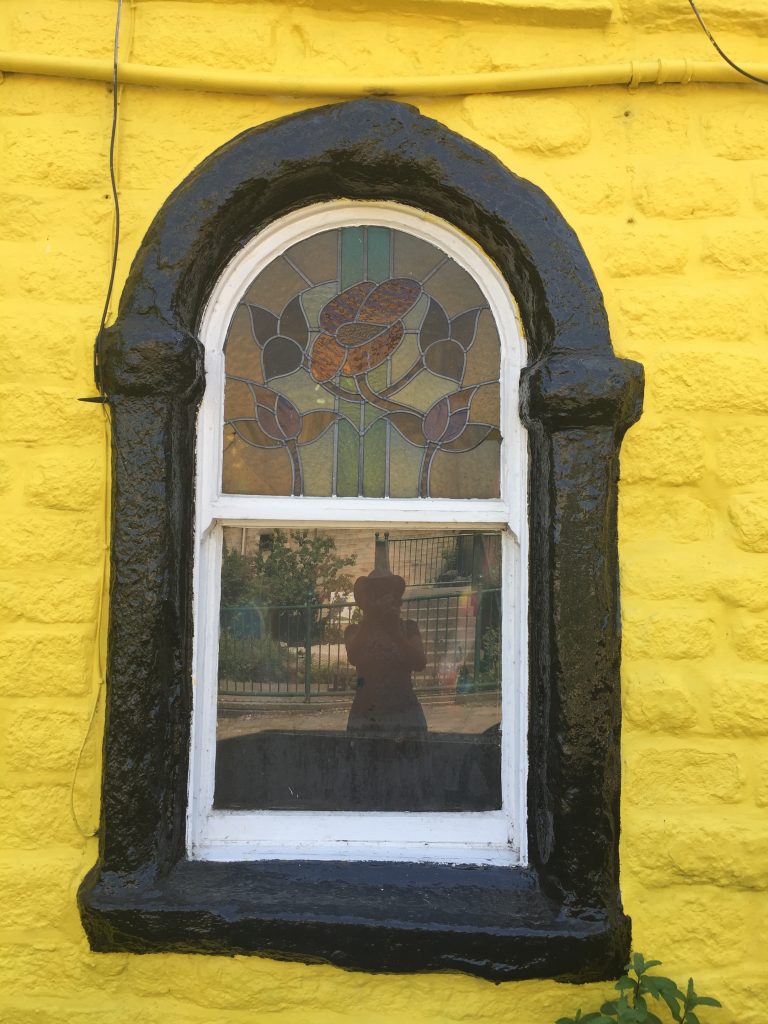
Nov 17, 1899. Todmorden and district News:
TODMORDEN DROWNING CASE PROBABLE SUICIDE. THE CORONER’S INQUIRY
During the breakfast half-hour Monday morning great excitement, prevailed in the neighbourhood of the Golden Lion bridge, Todmorden, by reason report that the dead body woman had been found floating in the canal and the sensation was increased by the fact that deceased’s husband appeared on the scene before the body had been recovered. and actually assisted in getting the lifeless form out of the water. The deceased was Rose Gibson, aged 54 years, wife Richard Gibson, millwright, of 5, Longfield Rd Todmorden. She was very well-known in Todmorden district, being at one time the landlady the York Hotel. It is stated that she was Gibson’s fourth wife, and that she herself had been previously married. The body was at once removed to 5, Longfield Rd Todmorden.. Rumours of a somewhat ugly character were freely circulated, but as nothing of the kind came out in the evidence tendered the inquest shall not refer to them in any way. Mr. W. Barstow. J.P.. held the inquest the Town Hall Tuesday, Councillor Robt. Gibson officiating as foreman of the jury. The first witness called was deceased husband, Richard Gibson, who said he last saw her alive about 5:30 or perhaps six o’clock, on Monday morning; they were then in bed together, as he did not start work until 9 on Monday mornings. He did not notice the time particularly, but thought it would about 6 o’clock when deceased got up. He asked her where she was going, and she replied that she felt a bit starved and was going make some hot cocoa. She partly dressed herself and went downstairs. He did not know whether she got the cocoa or not, but a short time afterwards she came upstairs again, and he felt her putting the clothes on him.. He did not see her again: he had no conversation with her the last time he saw her. He did not hear her leave the bedroom.When got up. about 7-30.he found she was not the house and he went in search of her. He went to her daughter, who cleans Mr. Sager’s office, but she had not been there: as far Cobden. and back again, making inquiries, but could hear nothing of her. Sergt. Nicholson observed that he met the witness by the Town Hall just after 7-30 a.m. Proceeding, witness said he then went back home, to see if she had turned up there, but she had not. He came out again, and when he got to the Golden Lion bridge he heard that there was woman in the canal. He went to look, and found it was his wife: he helped to get her out as several who stood never offered to give a hand. It would be about ten minutes or quarter past eight when found her in the canal just after the factories had loosed. He knew of no reason why his wife should go out when she did. She did no cleaning except helping her daughter occasionally and she had not been to her daughter that morning. He identified the body while it was in the water by deceased’s shawl and her hair. She was quite dead. The Coroner inquired if anything in the form of a letter had been found? Sergeant Nicholson: No. sir. I understand that there was a piece of rope attached to her clothing? Witness; No, was only a piece of string on the canal bank where we laid her. The Coroner; Can you give the jury any information as to how she got into the canal at that time the day? No I have no reason to give. —-Mr. A. Greenlees (a juryman):Was anybody about when you got there? Yes. there were fire or six around, and they could hare got her out: I had to ask four or five times before they would put a hand on.— The Foreman : Has she ever hinted at taking her life away, or thrown out any suggestion whatever that she would make herself away? Well, she has sometimes said she would: she told me on Sunday that she had been a bit queer at times ever since the change of life. She has also been a hit upset about letter from a niece in Middleton. A very little put her out —The Coroner: Has she been taking too much drink lately? I can’t tell.—How was she on Saturday and Sunday ? Well, Sunday night she wanted a pint bottle for beer, and I fetched her one from the White Hart – When did this letter come from Middleton? At the beginning of last week. —You say it put her about ? Yes I told her not to bother about it because she could not help it. Then the present condition of her daughter has caused her some anxiety. How far would the place where she was found lie from your house? Perhaps about a couple of hundred yards.—The Foreman: Had some suspicions made you go out seeking her as soon as you missed her? No. I had no suspicions at all.—The Coroner; did you ever think she was not quite right in her mind ? Only that she was a bit strange now and then: she had been subject to these “low doos” ever since the change.—The Coroner; you mean depression or spirits, or depression of mind? Yes. —Had she any pain or headache? She had pain at the side.—Do you know whether she made the cocoa or not ? I don’t know; she hadn’t lit the fire, but we have a gas stove.—l was thinking that the cocoa might be all an excuse get out ? Well, I didn’t find any pot containing cocoa; the vinegar bottle was on the table, as if she had had a drop of vinegar. Mary Whitehead wife of Samuel Whitehead, out-door labourer, Back Longfield-road, said she had been with her husband’s breakfast, on Monday morning, and she was coming back, about five minutes to eight, she met the deceased just below her own house. The deceased was coming down Longfield road, which would lead her to the canal. Witness noticed nothing unusual or strange about her; she had a black shawl on her head, and was holding it with her hand. They did not speak at all. Edwin Robinson, ice cream manufacturer, Hollins Road. Walsden, said he came down the canal bank to his work on Monday morning. When got to the wharf he noticed two children in front of him and on reaching “Neddy-brig”lock they called out “Come here, there’s a woman in the cut.” He got hold of the woman’s left shoulder, and raised her up : her head immediately dropped back, and concluding that she was dead, he at once ran into the main road for assistance. He saw Mr. Moores, draper, Waterside, who went on the canal bank with another man and pulled her out while he(witness) went the police station. This would be about ten minutes past eight. In answer to the Coroner, the jury stated that it would not take deceased more than two minutes walk from where Mrs. Whitehead saw her to where the witness Robinson found her. Ellen Maria Farrar, wife of Farrar, plasterer, Cockpit, Longfield Road deposed to assisting her mother to lay out the body of the deceased on which there was no mark of violence or injury. Witness last saw Mrs Gibson alive on Sunday : she then seemed all right—in fact, witness had never seen her when she thought she was not all right. The Coroner, addressing the jury, said that was all the evidence proposed called, and it would be for them to return such a verdict as they thought the evidence justified. The woman was found drowned in the canal, without mark of violence or injury. It was for the jury to say, if they could, how she became drowned. It seemed rather strange that the woman should leave home, without any special reason at that time of the morning and within about a quarter hour of last being seen should be found dead in the canal—drowned in broad daylight. Mr. G. T. Moore (a juryman): The deceased’s husband said he left home to search for her about 7-30; Mrs. Whitehead she saw her just outside her own house, five minutes to 8. I can’t reconcile those two statements. The Foreman observed that the deceased’s husband seemed to be a bit muddled about the times. The Coroner: Yes, he was not very positive about the times, but Mrs. Whitehead was positive and the witness Robinson was equally positive. The woman has evidently got into the canal at a place which is quite safe that time of the morning, any rate. It almost looks if she had gone in purposely. But do you think there is sufficient evidence to show the state of her mind the time? Mr. Moore: Have we sufficient evidence to say that she has taken her own life ? The Coroner: Is there any other probable way of accounting for it? The Foreman asked deceased’s brother (who had entered the room short time before) could give any information as to a letter from Middleton which was said to have upset her very much ? Deceased’s brother replied that did not think any letter from Middleton had depressed her at all ; they had always been on very friendly terms. Mr. Alex. Wild (a juryman) said he did not see that they could come to any other conclusion than that suggested by the Coroner,on the evidence which bad been given. the —At the same time, deceased’s husband was not very clear about the Sunday : he did not say where she was or anything about her. Mr. Moore : She may hare been driven to it by something we know nothing all about. Mr. A. Greenlees (juryman) suggested an open verdict of “found drowned.” The Coroner, however, said that an open verdict was very unsatisfactory; it found nothing. Did the jury not think that in all probability it was a case of suicide ? The Foreman, pressed by the Coroner to express an opinion, said had no doubt that the woman had deliberately gone from home to the canal. Mr. Wild remarked that deceased was only partly dressed. He understood that had nothing on but a shawl and a skirt—no underclothing. After further conversation the jury unanimously agreed to verdict “Found drowned, without mark of violence or injury, having probably drowned herself, but not sufficient evidence to show the state her mind the time.” On the initiative of Mr. Walter Ratcliff the jury unanimously agreed that their fees amounting to 12s.. should be handed to some local fund in aid the wives and families of the reservists called out to war.
Rose had been married for a little over a year to Richard Gibson who took his own life in 1910 by hanging himself in his house at 17 Union Street, Todmorden. Richard’s father, Joshua Gibson, had also committed suicide in the slaughter house of his pub, the Bull inn, Bridge Lane, Hebden Bridge (see previous blog post). Before his marriage to Rose Richard had been married at least three time, the last marriage before Rose being to Mary Ann Whitaker who was formerly Holt. She was living at the Golden Lion in Todmorden at the time of the marriage in 1894 – either as husband to the landlord (?) or as a live in servant. After Rose’s death in 1899 I can next find Richard as a boarder at the Masonic hall opposite the White Hart inn in Todmorden.

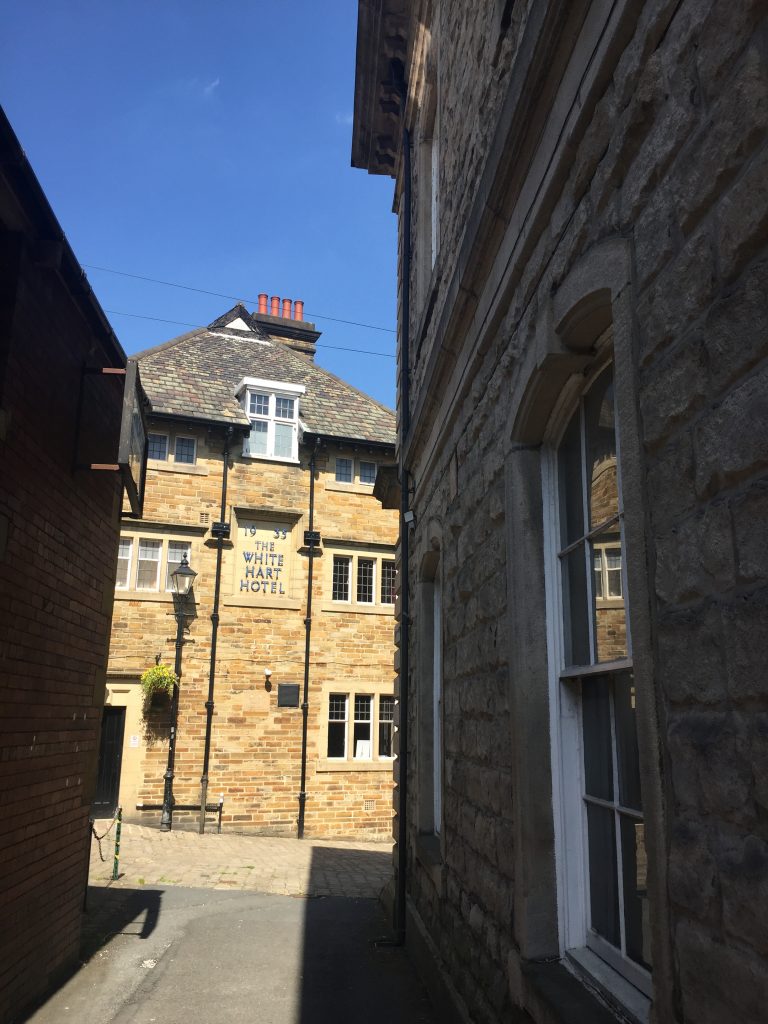
Masonic hall on right
It was opened in 1862 and is a Grade ll listed building. I posted a question on the Todmorden history Facebook page but no-one had ever heard of people living in the building. I was disappointed but then, a couple of weeks later Paul Rigg sent me this message:
My Dad had an office in the Masonic Hall from around 1964 until about 1976. There was a corridor when you went in and various offices until you got to the end where the stops went up to the “Masonic” bit. Beyond there was a kitchen and some living accommodation. At that time the lady who lived there was a Mrs Howell. She acted as cleaner and I think she catered for the Masons. Later they knocked down the internal walls and made a function room. It was very gloomy when you walked in and actually people though it was haunted. The front doors had no keys and if it was locked you had to clamber across a grill and go down a passage at the left hand side of the building. Then you let yourself in through the side door and walk down the corridor to unbolt the front door from the inside! All a bit spooky. My dad had the right hand offices. Roland Sutcliffe had the left hand ones. I think he was a textile agent. It was all a bit Dickensian.
Today as I looked at it for the first time I see that is a very substantial building but it looks disused. I walked around to the rear and it’s possible that another building has been added to it. A couple were sitting in their garden next door enjoying the unseasonably hot weather and they told me that the masons still use it occasionally for functions.
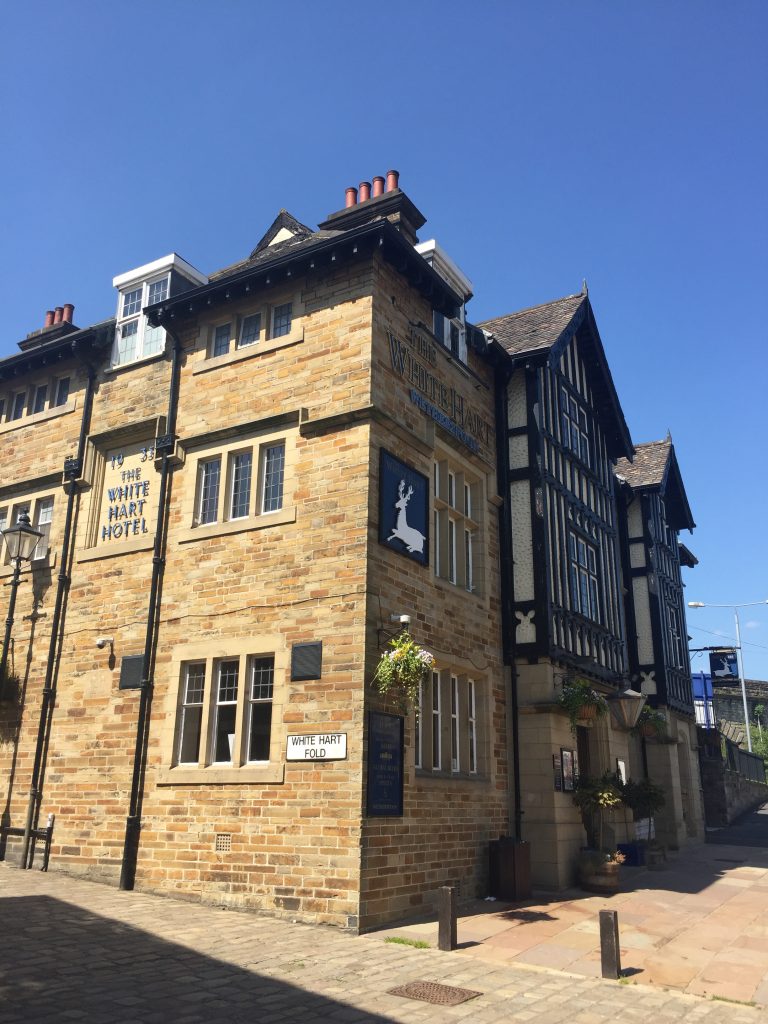
The White Hart has featured in my family history before, being the scene of the court session in which my great great great grandma claims child support from James Wrigley, her neighbour at Lily Hall. It’s also a place I had lunch with Sarah before I knew the Lily Hall connection. Now today, I find it is the place where Richard went to buy a beer for Rose the night before she died.
I’ve never been in the Golden Lion pub but I see that it’s been repainted since I last saw it – bright yellow on one side. It had a little stall of used clothing that people could take home and I was surprised to see that the beer garden was in full use, this still being lockdown time. Across from the Golden Lion is Cockpit, where Ellen Maria Farrar lived. She assisted in the laying out of the body of the deceased. A lady was gardening and explained my story.
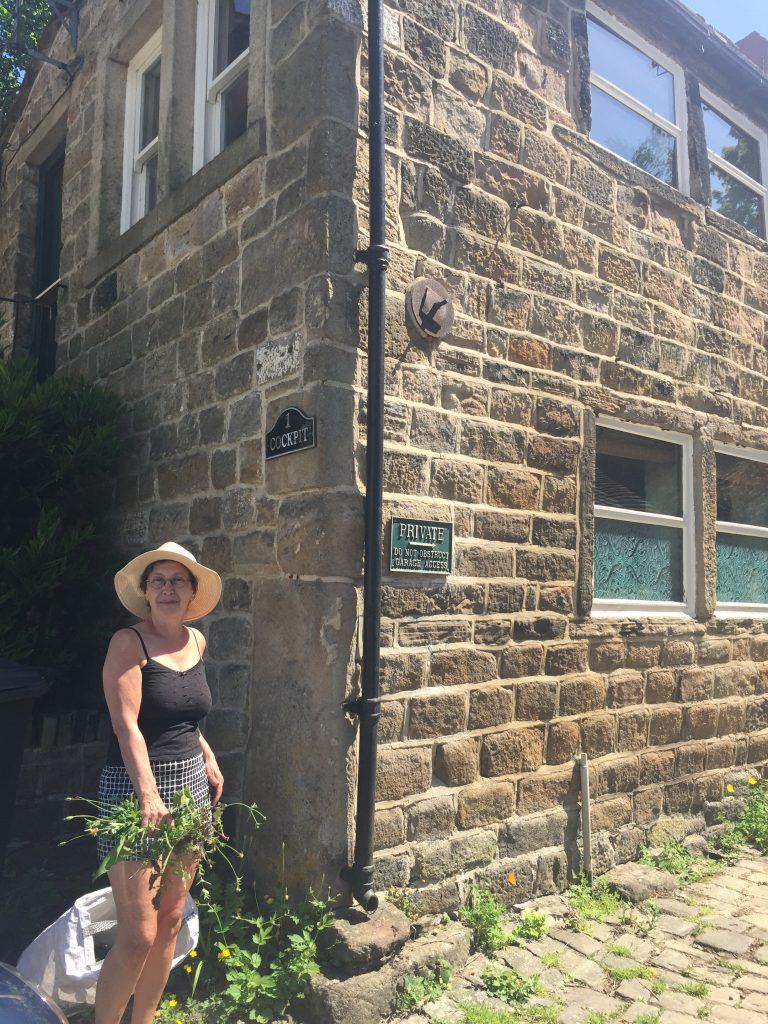
She was fascinated and we discussed whether in fact Rose’s death was a suicide. number 5 Longfield no longer exists though there is a section of canal bank almost adjoining the Golden Lion which may have had some houses on it. It currently sports a huge Kindness sign.

I crossed the main road and was immediately at the lock which is adjacent to the road bridge. It had taken me a while to discover that this was once known as Neddy Bridge after one of the former landlords of the Golden Lion – such is the benefit of posting questions on Facebook history sites! I realised that overlooking the lock is the garden of House des Lowe, a cafe I frequent in ‘normal’ times which is owned by my textile teacher and her husband! I’ll never be able to sit enjoying my coffee in the garden without thinking about Rose.


Update, November 23, 2020
Shortly after writing this I found a wonderful book of photographs called Todmorden Now and then in which Daniel Birch has superimposed old photos of Tod with current photos taken from the same place. Daniel brought the book over to me and I couldn’t believe my eyes when I found this photo. It shows the corner of the Golden Lion and behind it are the cottages in exactly the places where I thought that Rose’s house must have been. I’d found Rose’s house!
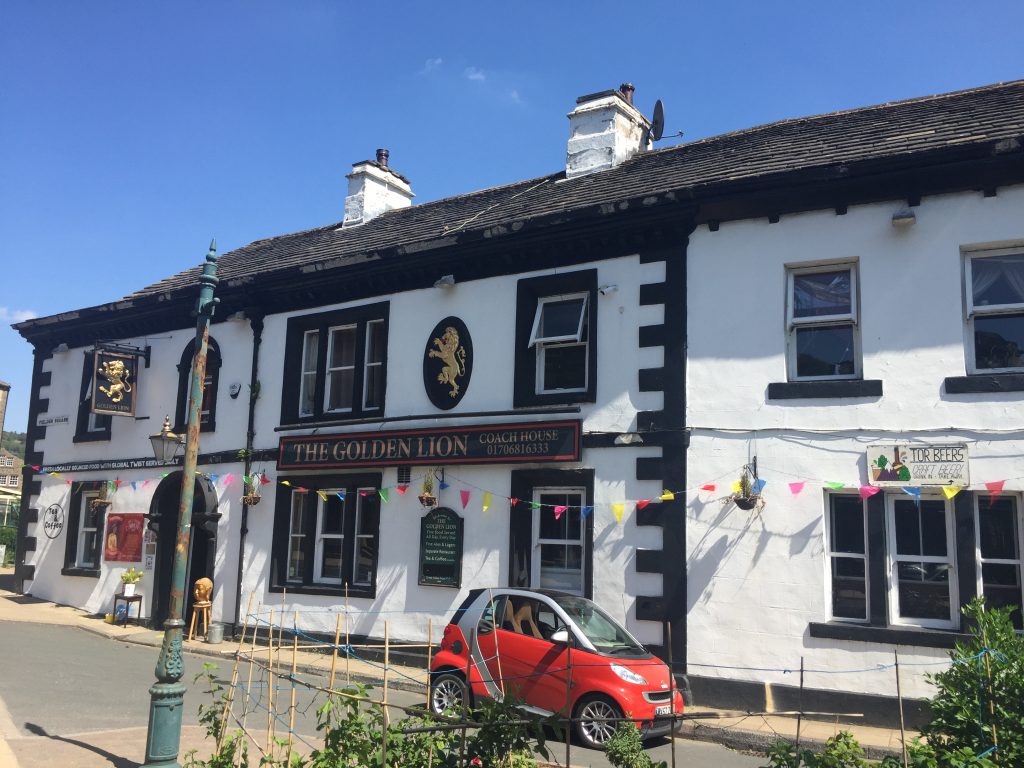
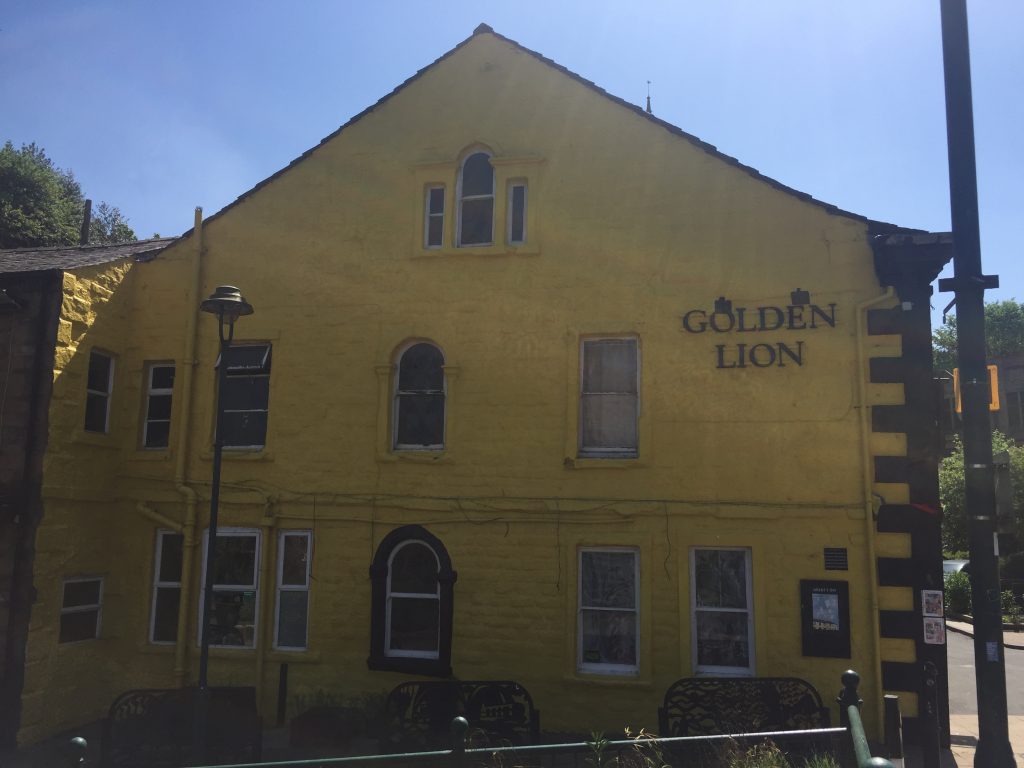
Leave a Reply